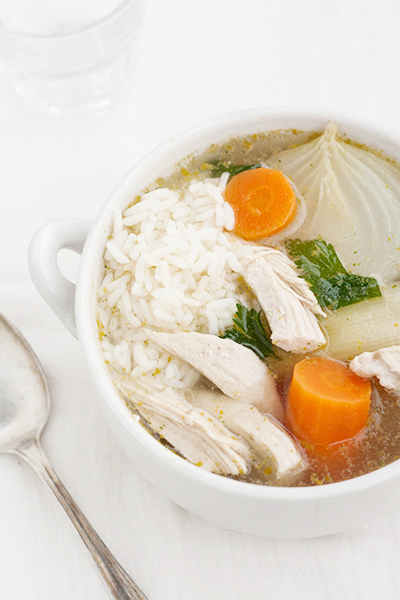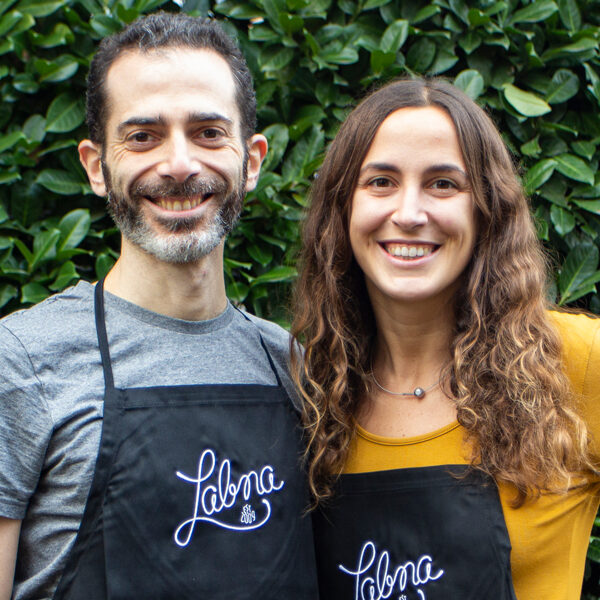The Best Jewish Chicken Soup
In winter, when you get home on a cold evening after a long, soul-crushing day at work, there is nothing better than a hot bowl of soup to warm your body and your spirit up. Sometimes I just crave a colorful minestrone or a creamy pumpkin soup, but some other days… only my mum’s proper Jewish chicken soup will do, I won’t settle for anything else.
Since this month’s topic for the Italian Table Talk project with my friends Giulia, Valeria, and Emiko is soup, my contribution to the discussion is the recipe for what is simply the best Jewish chicken soup I know, my mum’s, a soup that at home we informally call “shtetl soup”, for reasons I will explain below.
At my house, chicken soup is probably everyone’s number one comfort food. In Italy, chicken soup (which is mostly called simply brodo, broth) is typically enjoyed during holidays, for example at Christmas, when it is found at the table with tortellini pasta; Jewish families, however, enjoy it much more often. Jewish mothers worldwide believe that chicken soup is a cure for any ailment one might have, physical or emotional, hence the American habit of calling this soup Jewish penicillin.
It is not scientifically proven that the soup actually cures anything, but I can attest that it is a panacea for colds, stomach aches, and many other ailments I’ve experienced firsthand. It seems obvious to me that a soup lovingly prepared by one’s mother would make one feel better: love is the best medicine!
Predictably for a Jewish household, the typical caring “Yiddish mother” type of mum can also be found where I live – she birthed me and hasn’t stopped worrying about my well-being ever since. Throughout my life, even a single sneeze has been enough to always have a bowl of hot chicken broth immediately appear.
Now let me tell you why my mother renamed Italian “brodo di pollo” into “minestra dello shtetl”, or the shtetl soup. This dish is often associated with Ashkenazi cuisine, that is the Jewish cuisine of the Central and Eastern European countries, where the Jews lived in small towns called shtetls.
People in the shtetls often lived in great poverty, and farming a chicken was a valuable, relatively low-cost resource to feed a family. Hence the use of chicken, and chicken broth, in many traditional Ashkenazi recipes. Every family tried to get at least one chicken for Shabbat meals, sometimes with huge sacrifices, and made the most of it, utilizing every single part of the chicken and turning it into delicious dishes. With the least desirable, but still tasty leftover chicken scraps, such as the bones, they made soup.
Everyone has their own way of preparing chicken soup. Cooking chicken in water is a simple and ancient custom, common to all cultures, so there are basically as many recipes for chicken soup as cooks that are preparing it. I am offering you my own very best Jewish chicken soup, but feel free to add any additional ingredients you like until you find the perfect flavor for you.
This recipe should yield a rich, tasty, and nourishing broth, perfect to be served plain, but also great with cars such as pasta (ever tried Italian pastina?!), rice, or better still, classic matzo balls, the ultimate Ashkenazi dinner combo.
If you are feeling under the weather, or if someone you love is, this is all you need for an instant pick-me-up, cure-all chicken soup. Go for it!
Before we start, a small note about two ingredients: the chicken, obviously, and more notably, parsnip.
- I like to cook a whole chicken, but any bits and pieces will do as long as you use skin-on, chicken pieces that are on the bone. Fatter, dark meat works best, so if you are just buying chicken pieces get thighs, that’s my favorite option. Please don’t use a skinless, boneless, joyless chicken breast, nothing good will come out of it.
- I know that parsnip is not easily accessible everywhere in the world. Some places have it in every supermarket, in others, it’s a rare exotic product. I think it really makes a difference to the flavor of chicken soup, so I encourage you to try and source some.

The Best Jewish Chicken Soup
Ingredients
- 2 tbsp extra-virgin olive oil
- 2 celery ribs
- 1 garlic clove
- 1 onion
- 1 leek
- 1 kg chicken (details below)
- 2 carrots, peeled and cubed
- 1 parsnip, peeled and cubed
- 1 potato, peeled and cubed
- 1 handful of parsley
- 1 small bunch of dill (optional, I actually hate it)
- 1 rosemary sprig
- 2 bay leaves
- 1 tsp powdered turmeric
- 1 tbsp salt
- 1 peppercorn
Instructions
- Grab your onion, garlic, celery, and leek, and chop them finely with your food processor. You can leave some veggies whole if you enjoy eating them along with your soup, but for the most flavorful broth, I like to include ground, sautéed veggies.2 celery ribs, 1 garlic clove, 1 onion, 1 leek
- Place a large Dutch oven or pot over medium heat and add in the oil. Let the oil warm up for a minute, then add in the ground veggies. Sautée, stirring occasionally, for about 10 minutes minutes until the onion becomes translucent.2 tbsp extra-virgin olive oil
- Thrown in the pot all of the other ingredients listed, and cover with about 2 quarts of water.1 kg chicken (details below), 2 carrots, peeled and cubed, 1 parsnip, peeled and cubed, 1 potato, peeled and cubed, 1 handful of parsley, 1 small bunch of dill (optional, I actually hate it), 1 rosemary sprig, 2 bay leaves, 1 tsp powdered turmeric, 1 tbsp salt, 1 peppercorn
- Bring the liquid to a boil, then reduce heat, and simmer for at least one hour: the longer the soup cooks, the better it tastes. If you own a pressure cooker feel free to use it to speed up the cooking.
- Pour the broth through a fine kitchen strainer. Gently take out the cubed vegetables and the chicken, and discard the smaller vegetables and the herbs. Pull the chicken meat from the bones, and discard the bones.
- Refrigerate the broth for 8 hours or overnight, then skim the fat from the surface, unless you want to have it straight from the pot and full of fat - not as clear but a lot more nutritious.
- Enjoy your soup on its own, with veggies and chicken on the side, or cook rice, pasta, or matzo balls in it to turn it into an ever richer meal.





E’ una cosa che avrei voluto fare proprio per questa settimana, il brodo di pollo. Poi, a proposito di giornate frenetiche… ;-)
Tu sei bravissima, perchè lo sappiamo quanto caspita è difficile fotografare brodi, per non parlare di quelli un po’ carichi come da volatile…
la foto mi piace assai
bacini amica, e grazie!
Complimenti per la tua intervista sul Corriere di oggi!
@Sabina grazie! pensa che io non l’ho ancora nemmeno letta perchè sono in ufficio, e sto morendo di curiosità! :)
Effettivamente, guardando i video degli spettacoli di Moni Ovadia, il personaggio ricorrente della “Yiddishe mame” è veramente esilarante … comunque nulla di nuovo sotto il sole del mediterraneo!
Tornando al brodo … la mia suocera – che non è “yiddishe”, ma non le manca nessuno degli altri attributi di “mammitudine”, e a me piace che sia così (!!!) perchè quando si dimentica(molto spesso)che sono una “perfida nuora” mi vizia e mi coccola come una bambina – insomma la suocera aggiungerebbe un chiodo di garofano conficcato nella cipolla che dà al brodo un tocco di esotica eleganza!
Ricetta ottima per queste giornate invernali!
Shabbat shalom, Jasmine!:)
@Maria S. Grazie! Shabbat shalom anche a te! :)
@Mariaf Ahah, alla fine tutte le mamme (e le suocere ancor di più!) sono un po’ yiddishe… :)
Questo brodo va benissimo per preparare un classico risotto alla veneta con riso vialone nano e una spruzzata di vino,mantecato col grana.
siete grandi! sia come persone, sia come giornalisti, storici, cuochi, simpatia, serietà, attendibilità, be’ non so più cosa dire, è un piacere leggervi
vi ho fatto già l’anno scorso un like su facebook e mi arrivano le vostre ricette, ma il bello del vostro sito è anche conoscere la vostra cultura e le vostre tradizioni
io ho il marito polacco e per me è una cosa molto buffa leggere le vostre ricette e scoprire che sono quelle che faceva mia suocera che non era ebrea (e questo è un motivo per prendere in giro mio marito quando dice che sono ricette polacche autentiche! ; ))
grazie per farci partecipare alla vostra storia gastronomica
…peccato che ultimamente siete un po’ meno attivi…. ma immagino che abbiate ben altro da fare!
a presto! Graziella Piccioni
Ciao :-) sono una fan del brodo!!! Esule in uk da 30 anni..ho investito in una mega pentola, appunto x il brodo…
Io ci aggiungo anche un pezzo di carne di manzo, e ossa con il midollo, alloro, e due chiodi di garofano (ricetta di nonna!)…Poi, con la carne faccio polpette, che non si spreca niente, no?
Grazie x cri
@Cristina sembra delizioso :)